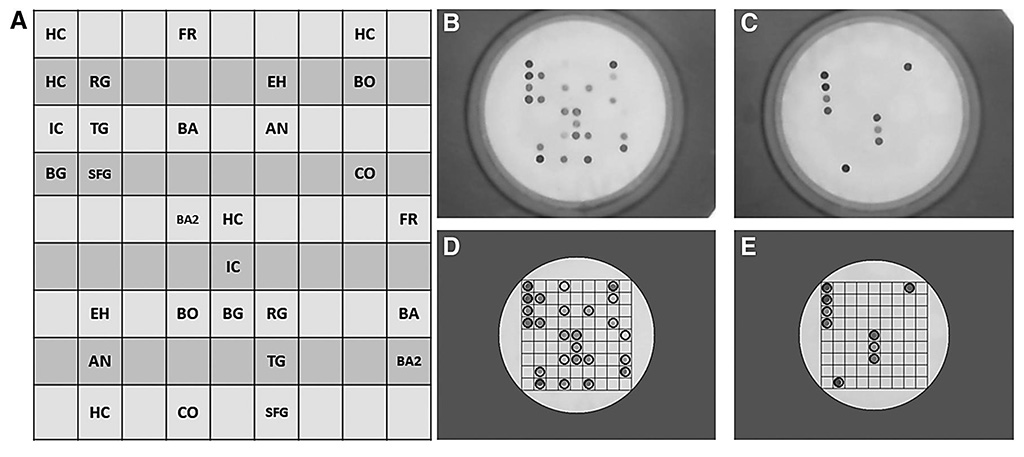Rapid DNA Flow Technology Platform Detects Tick-Borne Bacterial Pathogens
|
By LabMedica International staff writers Posted on 13 Nov 2019 |

Image: Simultaneous detection of Anaplasma spp., Bartonella spp., Borrelia spp., Coxiella burnetii, Francisella spp., and Rickettsia spp. on a tick-borne bacteria flow chip (TBFC) kit (Photo courtesy of Rutgers University).
Ticks are the most important vectors for infectious diseases in the northern hemisphere and second only after mosquitos worldwide. As a result, there is an increasing public health interest in tick-borne pathogens.
Ticks can transmit diseases such as Lyme disease, human granulocytic anaplasmosis, and spotted fever rickettsioses, among others. Therefore, there is a growing need to develop better and faster diagnostic tools that can detect zoonotic human pathogens in clinical samples.
Medical Infectious Disease Scientists from Rutgers University (New Brunswick, NJ, USA) and their international colleagues collected samples from 212 patients who presented a broad range of clinical signs/symptoms consistent with multisystem disorders that could be suggestive of an infection caused by any of the pathogens included in the panel of the tick-borne bacteria flow chip (TBFC) kit. Human DNA was used to spike positive controls came from cerebrospinal fluid (CSF) or biopsies from patients who tested negative to the pathogens included in the testing of the TBFC kit.
The TBFC is intended for the simultaneous qualitative detection of DNA from seven different genera of tick-borne bacteria, Anaplasma, Ehrlichia, Borrelia, Bartonella, Coxiella, Rickettsia, and Francisella, using a multiplex PCR followed by reverse dot blot automatic hybridization into a macroarray CHIP based on DNA-Flow Technology (hybriSpot). The kit offers the amplification of bacterial DNA by two multiplex polymerase chain reactions (PCRs) containing all primers for the specific amplification of the seven bacteria genera and two sets of primers for the amplification of two internal controls.
The scientists reported that the sensitivity of the TBFC was tested for each pathogen independently in the presence of human DNA. Despite human co-infections with tick-borne pathogens being rare, one of the strengths of the TBFC is that it can detect them. To prove that the TBFC detects co-infections, they included positive controls (103–104 plasmid copy/genome equivalents, PC/GE) for each pathogen. The results confirmed that the TBFC could detect all the pathogens simultaneously without compromising its sensitivity.
The TBFC platform offers four significant advantages. First, it is rapid and automatized, significantly shortening the time for the diagnosis of tick-borne pathogens. The TBFC kit gives results in 3.5 hours, while the in-house PCR-reverse line blot takes 8.5 hours for one pathogen. Second, it allows the simultaneous detection of multiple pathogens, which represents an excellent advantage for diseases that display similar symptoms early on. Third, the TBFC can analyze a wide variety of clinical samples with high sensitivity and specificity. Fourth, it is a valuable alternative to serology for early diagnosis.
The authors concluded that the TBFC kit is a rapid and highly sensitive and specific diagnostic tool, capable of simultaneously screening multiple bacterial pathogens. The study was published on October 22, 2019 in the journal Vector-Borne and Zoonotic Diseases.
Related Links:
Rutgers University
Ticks can transmit diseases such as Lyme disease, human granulocytic anaplasmosis, and spotted fever rickettsioses, among others. Therefore, there is a growing need to develop better and faster diagnostic tools that can detect zoonotic human pathogens in clinical samples.
Medical Infectious Disease Scientists from Rutgers University (New Brunswick, NJ, USA) and their international colleagues collected samples from 212 patients who presented a broad range of clinical signs/symptoms consistent with multisystem disorders that could be suggestive of an infection caused by any of the pathogens included in the panel of the tick-borne bacteria flow chip (TBFC) kit. Human DNA was used to spike positive controls came from cerebrospinal fluid (CSF) or biopsies from patients who tested negative to the pathogens included in the testing of the TBFC kit.
The TBFC is intended for the simultaneous qualitative detection of DNA from seven different genera of tick-borne bacteria, Anaplasma, Ehrlichia, Borrelia, Bartonella, Coxiella, Rickettsia, and Francisella, using a multiplex PCR followed by reverse dot blot automatic hybridization into a macroarray CHIP based on DNA-Flow Technology (hybriSpot). The kit offers the amplification of bacterial DNA by two multiplex polymerase chain reactions (PCRs) containing all primers for the specific amplification of the seven bacteria genera and two sets of primers for the amplification of two internal controls.
The scientists reported that the sensitivity of the TBFC was tested for each pathogen independently in the presence of human DNA. Despite human co-infections with tick-borne pathogens being rare, one of the strengths of the TBFC is that it can detect them. To prove that the TBFC detects co-infections, they included positive controls (103–104 plasmid copy/genome equivalents, PC/GE) for each pathogen. The results confirmed that the TBFC could detect all the pathogens simultaneously without compromising its sensitivity.
The TBFC platform offers four significant advantages. First, it is rapid and automatized, significantly shortening the time for the diagnosis of tick-borne pathogens. The TBFC kit gives results in 3.5 hours, while the in-house PCR-reverse line blot takes 8.5 hours for one pathogen. Second, it allows the simultaneous detection of multiple pathogens, which represents an excellent advantage for diseases that display similar symptoms early on. Third, the TBFC can analyze a wide variety of clinical samples with high sensitivity and specificity. Fourth, it is a valuable alternative to serology for early diagnosis.
The authors concluded that the TBFC kit is a rapid and highly sensitive and specific diagnostic tool, capable of simultaneously screening multiple bacterial pathogens. The study was published on October 22, 2019 in the journal Vector-Borne and Zoonotic Diseases.
Related Links:
Rutgers University
Latest Technology News
- New Noninvasive Methods Detect Lead Exposure Faster, Easier and More Accurately at POC
- Noninvasive Test Detects Malaria Without Blood Sample
- Low-Cost, Portable Device Detects Colorectal and Prostate Cancer in An Hour
- Light-AI Cancer Diagnosis Technology Could Eliminate Need for Traditional Blood Draws and Biopsies
- Chip-Based Blood Test Accurately Diagnoses Heart Attack in Minutes
- Cheap, Paper-Based Testing Platform Could Transform Diagnostics
- New Serological Pipet Controller Features Groundbreaking Repeat Dispense Ability
- Breath-Based Sampling System Diagnoses Lower Respiratory Tract Infection
- POCT Device Monitors C-Reactive Protein Levels Associated with Inflammation in Real Time
- New Microfluidics Method to Speed Up Blood Analyses
- AI Tongue Analysis Model 98% Accurate in Detecting Diseases
- Microneedle Patch Detects Skin Cancer Early
- New Diagnostic System Achieves PCR Testing Accuracy
- DNA Biosensor Enables Early Diagnosis of Cervical Cancer
- Self-Heating Microfluidic Devices Can Detect Diseases in Tiny Blood or Fluid Samples
- Breakthrough in Diagnostic Technology Could Make On-The-Spot Testing Widely Accessible
Channels
Clinical Chemistry
view channel.jpg)
POC Saliva Testing Device Predicts Heart Failure in 15 Minutes
Heart failure is a serious condition where the heart muscle is unable to pump sufficient oxygen-rich blood throughout the body. It ranks as a major cause of death globally and is particularly fatal for... Read more
Screening Tool Detects Multiple Health Conditions from Single Blood Drop
Infrared spectroscopy, a method using infrared light to study the molecular composition of substances, has been a foundational tool in chemistry for decades, functioning similarly to a molecular fingerprinting... Read more
Integrated Chemistry and Immunoassay Analyzer with Extensive Assay Menu Offers Flexibility, Scalability and Data Commutability
As global healthcare systems increasingly shift towards networked laboratory operational models to enhance efficiency and patient access, there is a greater need for innovative solutions tailored to the... Read moreMolecular Diagnostics
view channel
Respiratory Panel to Help Clinicians Make Precise Treatment Decisions in Outpatient Settings
Respiratory tract infections are the primary reason for visits to emergency departments and subsequent hospitalizations. In the U.S., it is estimated that there are up to 41 million cases of influenza... Read more
Integrating Cardiovascular Risk Biomarkers Aids in Detection of ‘Inflammaging’
Cardiovascular diseases (CVD) continue to be the leading cause of death globally, responsible for nearly one-third of all fatalities worldwide. Traditionally, risk assessment for CVD has focused on well-established... Read more
Genetic Signature in Newborns Predicts Neonatal Sepsis Before Symptoms Appear
Neonatal sepsis, which occurs due to the body’s abnormal response to severe infection within the first 28 days of life, results in approximately 200,000 deaths globally each year. This condition affects around 1.... Read more.jpeg)
Integrating Multiple Protein Markers Predicts Health Outcomes in Chronic Kidney Disease Patients
Previous attempts to discover novel kidney biomarkers as risk factors for chronic kidney disease (CKD) progression have generally focused on evaluating proteins individually, which limits their prognostic... Read moreHematology
view channel
Next Gen CBC and Sepsis Diagnostic System Targets Faster, Earlier, Easier Results
Every hour is critical in protecting patients from infections, yet there are currently limited tools to assist in early diagnosis before patients reach a hospital. The complete blood count (CBC) is a common... Read more
Newly Discovered Blood Group System to Help Identify and Treat Rare Patients
The AnWj blood group antigen, a surface marker discovered in 1972, has remained a mystery regarding its genetic origin—until now. The most common cause of being AnWj-negative is linked to hematological... Read more
Blood Platelet Score Detects Previously Unmeasured Risk of Heart Attack and Stroke
Platelets, which are cell fragments circulating in the blood, play a critical role in clot formation to stop bleeding. However, in some individuals, platelets can become "hyperreactive," leading to excessive... Read moreImmunology
view channel
Computational Tool Predicts Immunotherapy Outcomes for Metastatic Breast Cancer Patients
Immunotherapy aims to enhance the body’s immune response to target cancer cells, but not all patients experience a positive reaction to such treatments. Identifying which patients will benefit from immunotherapy... Read more
Biomarker Could Predict Immunotherapy Response in Liver Cancer
Until recently, patients diagnosed with hepatocellular carcinoma had limited treatment options, with existing therapies extending life by only a few months. Immunotherapy has emerged as a new alternative... Read more
Epigenetic Test Could Determine Efficacy of New Immunotherapy Treatments Against Multiple Myeloma
Multiple myeloma is a blood cancer that primarily affects individuals over the age of sixty, and its occurrence rises as the population ages. In this disease, the bone marrow—the spongy tissue inside bones... Read morePathology
view channel
New Imaging Method Opens Door to Precision Diagnostics for Head and Neck Cancers
Head and neck cancers, while considered rare, represent a significant portion of cancer cases and have seen a notable increase over the past 30 years. These cancers encompass various malignant tumors that... Read more
Faster Measurement of Vibrational Fingerprint of Molecules to Advance Biomedical Diagnostics
Identifying different types of molecules and cells is a vital process in both basic and applied science. Raman spectroscopy serves as a widely utilized measurement technique for this purpose.... Read moreTechnology
view channel
New Noninvasive Methods Detect Lead Exposure Faster, Easier and More Accurately at POC
Exposure to lead can negatively affect health in multiple ways, leading to damage in the brain and central nervous system, delays in development and growth, learning and behavioral issues, problems with... Read more
Noninvasive Test Detects Malaria Without Blood Sample
Malaria remains a significant global health issue, with approximately 250 million cases and over 600,000 deaths reported annually. Nearly half of the world's population is at risk for malaria infection,... Read moreIndustry
view channel
Beckman Coulter Partners with BioPorto for Global Distribution of Acute Kidney Injury NGAL Tests
Acute kidney injury (AKI) is a sudden episode of kidney failure or damage that can occur within a few hours or days. This condition leads to the accumulation of waste products in the blood and disrupts... Read more_1.jpg)
CACLP 2025 New Date and Venue Announced
The 22nd China International In Vitro Diagnostic Expo, organized by the China Association of Clinical Laboratory Practice Expo (CACLP, Shanghai, China), is set to take place from March 21 to 24, 2025,... Read more
Roche to Develop New Diagnostic Technologies for Traumatic Brain Injuries
Traumatic brain injuries (TBI) represent a significant global health issue, affecting approximately 69 million people each year. TBI occurs when an external force disrupts normal brain function, with severity... Read more
















